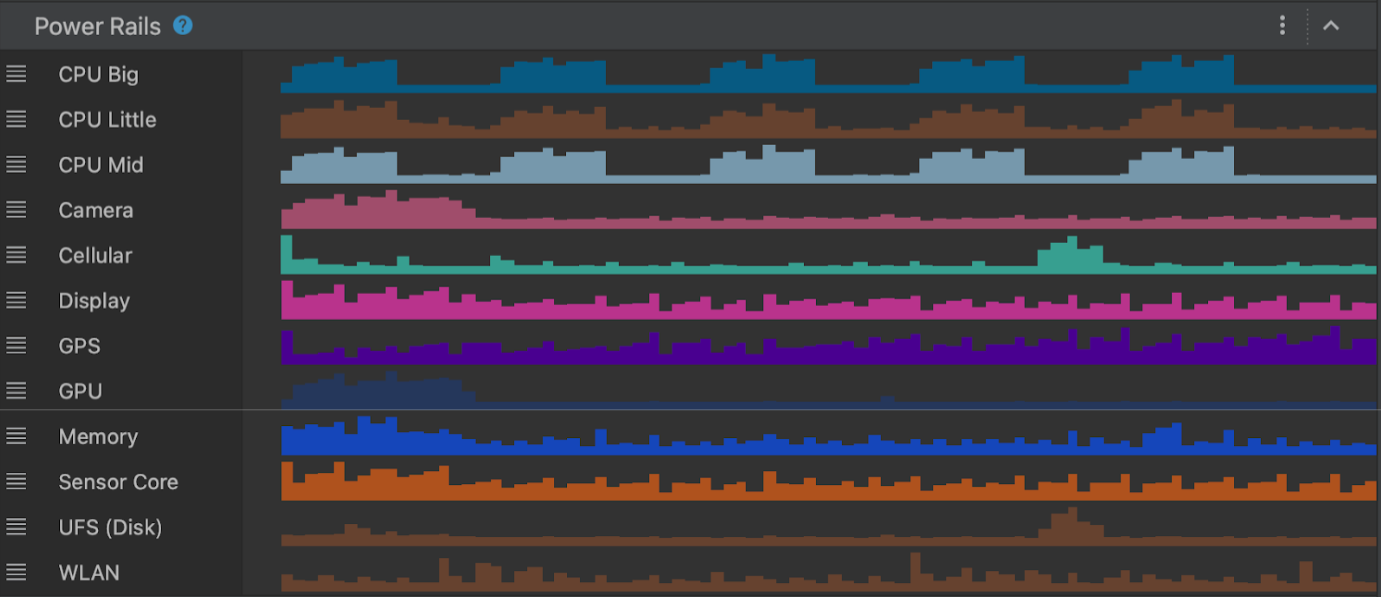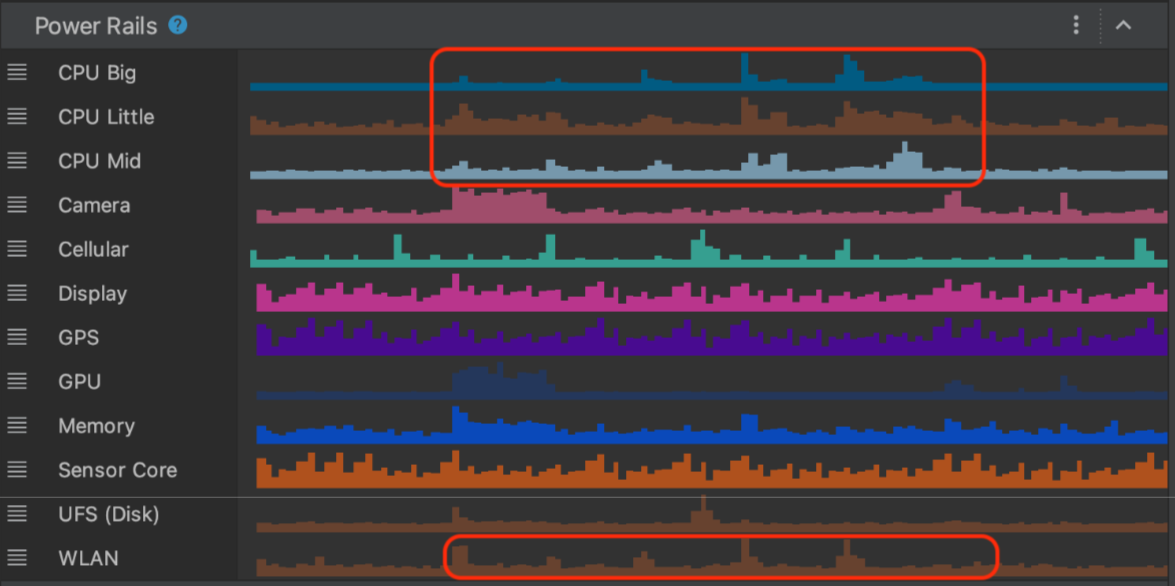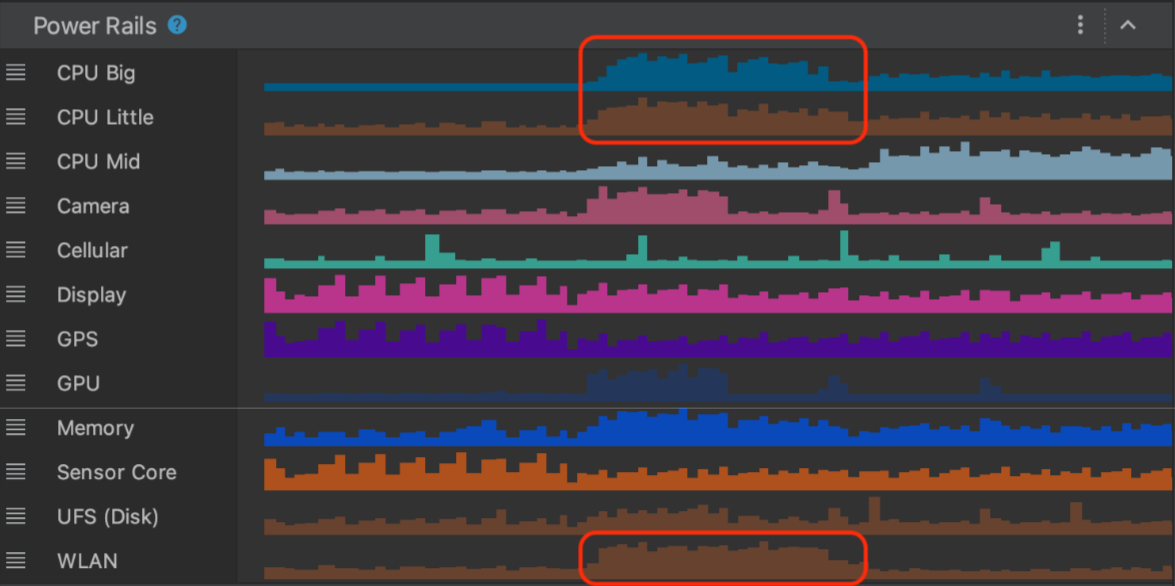החל מ-Android Studio Hedgehog, כלי Power Profiler מציג את צריכת החשמל במכשירים. אפשר לראות את הנתונים החדשים האלה בכלי On Device Power Rails Monitor (ODPM). המידע מפולח לפי מערכות משנה שנקראות Power Rails. רשימה של מערכות משנה נתמכות מופיעה במאמר בנושא פסי הספק שאפשר ליצור להם פרופיל.
האפשרות System Trace (מעקב אחר המערכת) מתעדת ומציגה נתוני צריכת חשמל. הוא חלק מהכלי ליצירת פרופיל של המעבד המרכזי. הנתונים האלה עוזרים לכם ליצור קורלציה חזותית בין צריכת החשמל של המכשיר לבין הפעולות שמתרחשות באפליקציה. הכלי Power Profiler מאפשר להציג את הנתונים האלה באופן חזותי.

מסילות מתח שניתן ליצור מהן פרופיל
ה-ODPM מדווח על כל מסילות החשמל שניתן ליצור להן פרופיל, והוא זמין ב-Android מגרסה 10 (API ברמה 29) ואילך, ובמכשירי Pixel 6 ומכשירי Pixel שבאו אחריו.
| שם פס הכוח | תיאור |
|---|---|
| CPU Big | ההספק שנצרך על ידי ליבת ה-CPU הגדולה. |
| מעבד Little | הספק שנצרך על ידי ליבת המעבד הקטנה. |
| CPU Mid | הספק שנצרך על ידי ליבת ה-CPU האמצעית. |
| מצלמה | ההספק שנצרך על ידי חיישן המצלמה. |
| רשת סלולרית | הספק שנצרך על ידי החיישן הסלולרי. |
| תצוגה | הספק שנצרך על ידי המסך. |
| GPS | הספק שנצרך על ידי חיישן ה-GPS. |
| GPU | הספק שנצרך על ידי חיישן ה-GPU. |
| זיכרון | הספק שנצרך על ידי חיישן זיכרון ה-RAM. |
| ליבת החיישן | צריכת חשמל על ידי חיישנים אחרים במכשיר. |
| UFS (דיסק) | הספק שנצרך על ידי חיישן הדיסק. |
| WLAN | הספק שנצרך על ידי חיישן ה-Wi-Fi. |
מכשירים שלא תומכים ב-ODPM יכולים לספק נתוני צריכת חשמל באמצעות מדידת קולון ומד הסוללה.
| שם | תיאור |
|---|---|
| קיבולת | אחוז הטעינה שנותר בסוללה (%). |
| חיוב | רמת הטעינה שנותרה בסוללה במיקרואמפר-שעה (µAh). |
| עכשיו | הזרם הרגעי במיקרואמפר (µA). |
תרחישים לדוגמה לשימוש ב-Power Profiler כדי ליצור פרופיל של צריכת החשמל
נניח שאתם מפתחים אפליקציה שצריכה להוריד נכסים דרך הרשת. אתם רוצים להבין איך משתנה צריכת החשמל של מסילת הכוח של ה-WLAN כשמורידים נכסים בנפרד לעומת הורדה של נתח גדול.
תרחיש א': האפליקציה שולחת בקשות רשת פרטניות כדי להוריד נכסים דרך WLAN.

תרחיש ב: האפליקציה שולחת בקשה אחת לרשת כדי להוריד נכס גדול מאוד דרך WLAN.

כפי שרואים בתרחישים הקודמים, בשני עקבות המערכת מוצגים חתימות שונות של צריכת חשמל בפס החשמל של ה-WLAN, בהתאם לאופן ההפעלה של ההורדה.
למרות שהדוגמה הקודמת היא דרך פשוטה למדידת צריכת החשמל בתרחישים שונים, היא ממחישה את התהליך שבאמצעותו אפשר ליצור בדיקות A/B מתוחכמות יותר לאפליקציה. אפשר להשתמש בבדיקות האלה כדי לבצע אופטימיזציה של צריכת החשמל בתכונות שונות או בהטמעות שונות של אותה תכונה.
הערות חשובות
- ה-ODPM מודד את צריכת החשמל ברמת המכשיר – לא ברמה של אפליקציה ספציפית. אתם יכולים לקשר בין נתוני צריכת החשמל מה-ODPM לבין מה שקורה באפליקציה שלכם ברקע או בחזית. לכן, יכול להיות שיהיו רעשים בנתוני צריכת החשמל, בהתאם למספר האפליקציות שפעילות במכשיר בזמן קריאת נתוני ODPM.
- הכלי Power Profiler קורא נתוני צריכת חשמל מ-ODPM, שזמין רק במכשירי Pixel 6 ומכשירי Pixel חדשים יותר עם Android 10 (API ברמה 29) ומעלה.
- חלק מפסים של מתח עשויים להיות זמינים רק במכשירים מסוימים שמטמיעים ODPM.

